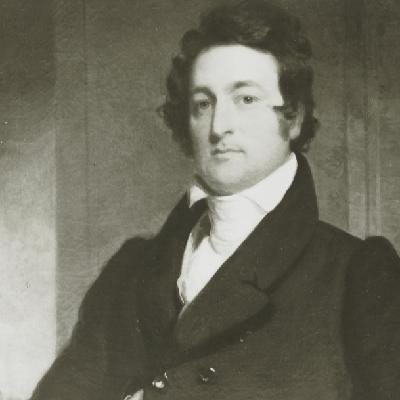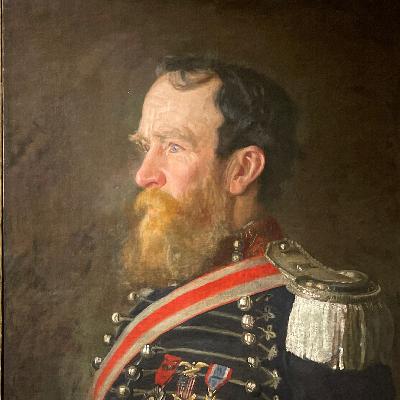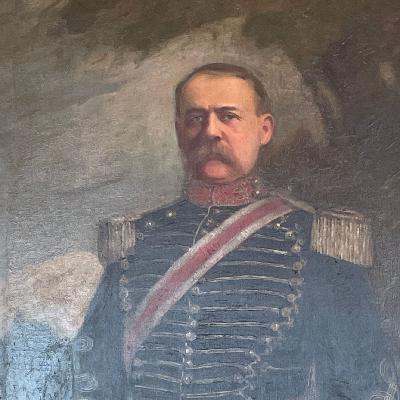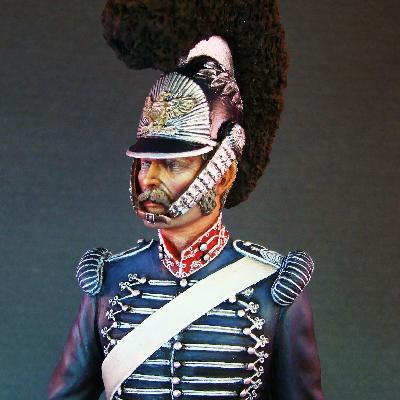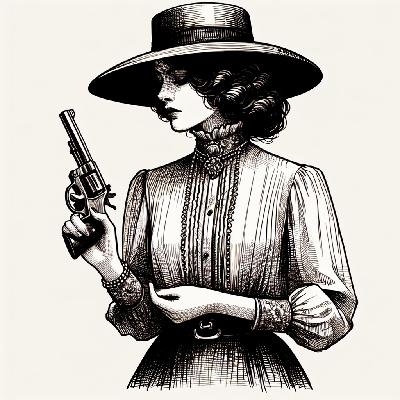Discover All Bones Considered: Laurel Hill Stories
All Bones Considered: Laurel Hill Stories

All Bones Considered: Laurel Hill Stories
Author: Joe Lex
Subscribed: 30Played: 931Subscribe
Share
© Copyright 2020 All rights reserved.
Description
Tales for taphophiles of permanent residents of Laurel Hill Cemetery in Philadelphia and West Laurel Hill Cemetery in Bala Cywnyd, Pennsylvania. Often educational, always entertaining.
335 Episodes
Reverse
All Bones Considered: Laurel Hill Stories #041, part 4
Benjamin Wood Richards' tenure as mayor coincided with challenges such as public health crises, infrastructure needs, and social tensions in Philadelphia. In 1819, Richards co-founded a large commission house in Philadelphia, a business acting as an intermediary for securities and commodities transactions, earning income through commissions. He served in the Pennsylvania legislature in 1827, advocated for public schools, was a canal commissioner, and was appointed by President Andrew Jackson to direct the U.S. Bank and Mint. Appointed mayor in 1829 and elected in 1830-31, wealthy merchant Stephen Girard died during his term. Richards helped found the Girard Trust Company in 1835, serving as its president until his death, with the bank later becoming Girard Bank. When Richards toured Europe, he was inspired by Paris’s Père Lachaise Cemetery, and helped found Philadelphia’s Laurel Hill Cemetery, where he was a major stakeholder.
All Bones Considered: Laurel Hill Stories #081, part 3
Nathan Dunn was born to Quaker parents in New Jersey. After early financial difficulties and disownment by the Philadelphia Quaker Meeting, he sailed to China around 1818 to rebuild his fortunes. In Canton, he gained respect by avoiding the opium trade and engaged in commerce involving tea, silks, porcelain, and other goods. In 1835 he joined with John Jay Smith and others to form Laurel Hill Cemetery, for which he served as primary financial backer.
Dunn’s decade-long residence in China allowed him to collect a vast array of authentic Chinese artifacts, reflecting a broader American interest in understanding China beyond commerce. His collection later formed the basis of the Chinese Museum in Philadelphia, opened in 1838, one of the first American institutions dedicated exclusively to Chinese culture. The museum featured thousands of objects, life-size wax figures, dioramas, and detailed exhibits of daily life, religion, and governance in China. Dunn transferred the museum to London in 1842, where it was visited by Queen Victoria and Prince Albert. Late in life, he was accused of illegal homosexual activity and put on trial for the crime of sodomy.
From All Bones Considered: Laurel Hill Stories #081, part 2 - released December 3, 2025.
When Laurel Hill Cemetery co-founder John Jay Smith died in 1881 at age 83, he left behind a significant legacy in Philadelphia’s cultural and civic institutions. His obituary highlighted his diverse roles as librarian, editor, cemetery founder, and member of the Society of Friends, as well as his family lineage connected to other notable Philadelphia founders. Other accomplishments included introducing paper made from straw and inventing something that sounds suspiciously like the Book of the Month club a century before the real thing.
Part 1 of All Bones Considered: Laurel Hill Stories #081: Laurel Hill - In the Beginning
Inspired by the allegory of Old Mortality, Laurel Hill was founded in 1836 by John Jay Smith and other reform-minded citizens as a response to overcrowded urban graveyards and changing attitudes toward death and memorialization. Modeled after rural cemeteries like Paris’s Père Lachaise, Laurel Hill emphasized scenic landscaping, remembrance, and inclusivity for various religious and social groups, although early regulations still reflected social prejudices. The founders established distinctive rules, invested in prominent sculptures and monuments, and promoted the cemetery through “celebrity corpses” and innovative designs by architects such as John Notman. Laurel Hill’s development mirrored broader trends in American burial practices, the rural cemetery movement, and the expansion of non-sectarian spaces for commemoration and education, while also sparking debates about the relationship between beauty, solemnity, and social class in cemetery culture.
All Bones Considered: Laurel Hill Stories #081 for December 1, 2025
Laurel Hill Cemetery was founded in 1835 and opened in 1836 by four men with strikingly different backgrounds, but with a common cause - to give the people of Philadelphia a final resting place worthy of the "Athens of America."
John Jay Smith was a polymath librarian / horticulturalist who had a rather unpleasant experience in seeking the grave of a recently deceased daughter and vowed to change the way people commemorated their dead.
Nathan Dunn was initially a failed merchant who regained his fortunes in the Chinese trade and became the financial backing for the cemetery corporation.
Benjamin Richards was ex-mayor and a business partner of Smith's who on a trip to Europe was inspired by the revolutionary Pere Lachaise Cemetery in Paris to provide something similar in Philadelphia.
Along the way you will also learn about Sir Walter Scott, varying splinter sects of Christianity like the Swedenborgians, what the Opium Wars were really about, the history and significance of The Library Company of Philadelphia, with a brief look at Chinese male-male love as commemorated in the legend of the Cut Sleeve.
Lon Jourdet was an All-American footballer who also excelled at basketball. He spent 23 non-consecutive years as coach at Penn and captured more than 200 victories, but he left in 1943 with a bitter taste in his mouth for the University, which has come close to forgetting him. He ended his own life in 1959.
Biographical Bytes from Bala: Laurel Hill West Stories #050
The sport basket ball started on the day James Naismith nailed 13 rules to a gymnasium door in Springfield Massachusetts. The game spread quickly, especially among college men (and women). University of Pennsylvania was an early adapter, and four Penn grads made their names in basketball.
Ellwood Rutschman was a decent player but found his niche as the first professional basketball referee. He set the standards for fairness and ethics in the sport.
"Kid" Keinath was the Quakers' second coach after serving as captain. He was followed by his good friend "Artie" Kiefaber, namesake of the MVP award.
Lon Jourdet won more games in the 20th century than any other Penn basketball coach and was an inventor of the zone defense. But the game passed him by, and his firing in 1943 left him an embittered man.
All Bones Considered: Laurel Hill Stories #080, Part 5
Hugh Craig, Jr., was a successful businessman whose life became the Troop, where he served both as treasurer and as quartermaster. The men loved him, and they still hold a "Hughie's Breakfast" at the conclusion of every deployment.
All Bones Considered: Laurel Hill Stories #080, Part 4
Joseph Lapsley Wilson is better remembered today for his arboretum than his troop membership. It still exists today as the Barnes Arboretum at St. Joseph's University. He introduced several species of Asian trees to the United States. His portrait by Thomas Eakins hangs in the Armory Museum.
All Bones Considered: Laurel Hill Stories #080, part 3
Archibald Loudon Snowden was a polymath who served as Captain of the Troop, as well as postmaster for the city, supervisor of the Philadelphia mint, ambassador to Spain, along with numerous other roles. His portrait is in the armory dining room, and his descendants entertain millions of people.
All Bones Considered #080, Laurel Hill Stories, part 2
Fairman Rogers lived a life of elegant wealth, but made himself useful as an expert in many aspects of science, especially civil engineering. He was elected briefly as captain of the Troop. He also excelled was as a coachman, especially when he took his magnificent black and red four-in-hand through Fairmount Park. Philadelphia artist Thomas Eakins captured Rogers in a painting that is the first to accurately demonstrate motion in animals.
All Bones Considered: Laurel Hill Stories #080, part 1
The First Troop Philadelphia City Cavalry, or "First City Troop", was organized in 1774 as the Light Horse of the City of Philadelphia, often referred to as the Philadelphia Light Horse, one of the first patriotic military organizations established in the American Revolution. Although part of the National Guard system, it is a free-standing unit with its own uniforms and armory. It has served in virtually every war and skirmish ever entered by the United States. After a quarter century of service, it still proudly serves the American populace and the people of Philadelphia.
All Bones Considered: Laurel Hill Stories #080
November 1, 2025
First Troop Philadelphia City Cavalry, better known as First City Troop is in the midst of celebrating its semiquincentennial before the country does. Each segment will also be released separately.
Part 1 for November 2: a brief history of the First City Troop's First 150 years
Part 2 for November 3: Fairman Rogers was the finest coach driver in the land, especially the four-in-hand variety. His portrait by Thomas Eakins is a classic.
Part 3 for November 4: Archibald Loudon Snowden was a perfect example of a late-19th century polymath, becoming an expert in coin minting, the postal service, fire insurance, and Fairmount Park in addition to his years as a captain of the troop.
Part 4 for November 5: Joseph Lapsley Wilson quietly developed one of the finest arboretums in the country which continued under the care of Dr. Albert C. Barnes, who bought his property for a building in which to display his collection of artwork. It is now party of St. Joseph University.
Part 5 for November 6: Hugh Craig, Jr., was the grease that kept the troop moving and the glue that kept it together for more than 30 years, yet he lay in an unmarked grave at Laurel Hill East for more than a century.
Biographical Bytes from Bala: Laurel Hill West Stories #049, part 4
Oscar Rosier had married the prettiest salesgirl in town, who soon bore him a child. But Oscar had a roving eye which was apparently set on his secretary, another beauty and purported friend of his wife. It did not end well for anyone.
Biographical Bytes from Bala: Laurel Hill West Stories #049, part 3
Captain Clayton Erb decided to marry and produce an heir at age 50 and selected a young divorcee to serve as mistress of his Red Gables estate in Delaware County. When the woman's sister got involved, things went bad in a hurry. The court case revealed the mansion had been a house of horrors.
Biographical Bytes from Bala: Laurel Hill West Stories #049, part 2
John Hobbs knew he was being stalked and told his brother that if he didn't leave town soon, he would be a dead man. He was proved right when the woman he was avoiding caught up with him at the train station.
Biographical Bytes from Bala: Laurel Hill West Stories #049, part 1
Intimate Partner Violence dates to pre-biblical times and violence against women was sanctioned by laws until only recently. Up to 40% of all homicides involve a domestic partner. Men tend not to report abuse when it happens, although attitudes are changing. The adage that “Men are afraid women will laugh at them. Women are afraid men will kill them" is sometimes reversed. Here are three women who killed their intimate partner; their stories are anything but simple and straightforward.
Biographical Bytes from Bala #049
John Hobbs was stalked and shot at a railway station in 1891 by a spurned lover.
CPT Clayton Erb was shot and killed, either by his wife or his sister-in-law, during one of many knockdown drag-out battles that had occurred in the brief marriage at the Red Gables mansion in Delaware County.
In 1922, businessman Oscar Rosier and his secretary Jerry were mortally wounded by Rosier’s wife, who was thought to be the prettiest salesgirl in Philadelphia. Oscar lived long enough to write a will, which completely blocked his soon-to-be widow from his modest estate.
These three men were victims of mariticide. Their stories follow.
ABC079, Part 5
The tale of the arsenic widows of Philadelphia will never be told fully, and hundreds of men may have died at their hands. Two of the women who looked the guiltiest were saved from a life in prison by brilliant African American defense attorney Raymond Pace Alexander.
ABC #079, part 4
Victor "Babe" Andreoli was raised in East Falls in a large, hardworking family, but fell in with bad company and was sentenced to life in prison. It didn't go well.


